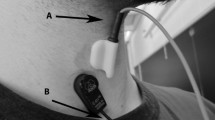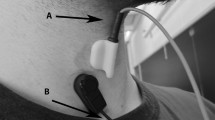Abstract
Dual-axis swallowing accelerometry is a promising noninvasive tool for the assessment of difficulties during deglutition. The resting and anaerobic characteristics of these signals, however, are still unknown. This paper presents a study of baseline characteristics (stationarity, spectral features, and information content) of dual-axis cervical vibrations. In addition, modeling of a data acquisition system was performed to annul any undesired instrumentation effects. Two independent data collection procedures were conducted to fulfil the goals of the study. For baseline characterization, data were acquired from 50 healthy adult subjects. To model the data acquisition (DAQ) system, ten recordings were obtained while the system was exposed to random small vibrations. The inverse filtering approach removed extraneous effects introduced by the DAQ system. Approximately half of the filtered signals were stationary in nature. All signals exhibited a level of statistical dependence between the two axes. Also, there were very low frequency oscillations present in these signals that may be attributable to vasomotion of blood vessels near the thyroid cartilage, blood flow, and respiration. Demographic variables such as age and gender did not statistically influence baseline information-theoretic signal characteristics. However, participant age did affect the baseline spectral characteristics. These findings are important to the further development of diagnostic devices based on dual-axis swallowing vibration signals.




Similar content being viewed by others
References
Akaike, H. A new look at the statistical model identification. IEEE Trans. Autom. Contr. 19(6):716–723, 1974.
Alves, N., and T. Chau, Stationarity distributions of mechanomyogram signals from isometric contractions of extrinsic hand muscles during functional grasping. J. Electromyogr. Kinesiol. 18(3):509–515, 2008.
Barron, A., J. Rissanen, and B. Yu, The minimum description length principle in coding and modeling. IEEE Trans. Inf. Theory, 44(6):2743–2760, 1998.
Bendat, J. S., and A. G. Piersol. Random Data: Analysis and Measurement Procedures, 2nd edn. New York, NY: Wiley, 1986.
Brockwell, P. J., and R. A. Davis., Time Series: Theory and Methods, 2nd ed. New York, NY: Springer-Verlag, 1991.
Cao, H., B. R. Ellis, and J. D. Littler, The use of the maximum entropy method for the spectral analysis of wind-induced data recorded on buildings. J. Wind Eng. Industr. Aerodyn. 72:81–93, 1997.
Chau, T., D. Chau, M. Casas, G. Berall, and D. J. Kenny, Investigating the stationarity of paediatric aspiration signals. IEEE Trans. Neural Syst. Rehabil. Eng. 13(1):99–105, 2005.
Cichero, J. A. Y. and B. E. Murdoch. Acoustic signature of the normal swallow: characterization by age, gender, and bolus volume. Ann. Otol. Rhinol. Laryngol. 111(7 Pt 1):623–632, 2002.
Clancy, E. A., and N. Hogan. Single site electromyograph amplitude estimation. IEEE Trans. Biomed. Eng. 41(2):159–167, 1994.
Colantuoni, A., S. Bertuglia, and M. Intaglietta. Quantitation of rhythmic diameter changes in arterial microcirculation. Am. J. Physiol. Heart Circ. Physiol. 246(4):508–517, 1984.
Cover, T. M., and J. A. Thomas. Elements of Information Theory, Wiley Series in Telecommunications. New York, NY: Wiley, 1991.
Das, A., N. P. Reddy, and J. Narayanan, Hybrid fuzzy logic committee neural networks for recognition of swallow acceleration signals. Comput. Meth. Progr. Biomed. 64(2):87–99, 2001.
Donoho, D. L. De-noising by soft-thresholding. IEEE Trans. Inf. Theory, 41(3):613–627, 1995.
Donoho, D. L., and I. M. Johnstone. Ideal spatial adaptation by wavelet shrinkage. Biometrika 81(3):425–455, 1994.
Ishida, R., J. B. Palmer, and K. M. Hiiemae, Hyoid motion during swallowing: factors affecting forward and upward displacement. Dysphagia, 17(4):262–272, 2002.
Kay, S. M. Modern Spectral Estimation: Theory and Application. Englewood Cliffs, NJ: Prentice Hall, 1988.
Kay, S. M., and S. L. Marple, Spectrum analysis—a modern perspective. Proc. IEEE 69(11): 1380–1419, 1981.
Kim, Y., and G. H. McCullough, Maximum hyoid displacement in normal swallowing. Dysphagia 23(3):274–279, 2008.
Lee, J., S. Blain, M. Casas, D. Kenny, G. Berall, and T. Chau. A radial basis classifier for the automatic detection of aspiration in children with dysphagia. J. NeuroEng. Rehabil. 3:14, 2006. doi:10.1186/1743-0003-3-14.
Lee, J., C. M. Steele, and T. Chau, Time and time-frequency characterization of dual-axis swallowing accelerometry signals. Physiol. Measure 29(9):1105–1120, 2008.
Lees, R. S. Phonoangiography: qualitative and quantitative. Ann. Biomed. Eng. 12(1):55–62, 1984.
Li, S. Z. Content-based classification and retrieval of audio using the nearest feature line method. IEEE Trans. Speech Audio Process. 8(5):619–625, 2000.
Lilliefors, H. W. On the Kolmogorov–Smirnov test for normality with mean and variance unknown. J. Am. Stat. Assoc. 62(318):399–402, 1967.
Ljung, L. System Identification: Theory for the User, 2nd edn. Upper Saddle River, NJ: Prentice-Hall, 1999.
Logemann, J. A. Evaluation and Treatment of Swallowing Disorders, 2nd ed. Austin, TX: PRO-ED, 1998.
Mann, H. B., and D. R. Whitney, On a test of whether one of two random variables is stochastically larger than the other. Ann. Math. Stat. 18(1):50–60, 1947.
Marple, L. A new autoregressive spectrum analysis algorithm. IEEE Trans. Acoust. 28(4):441–454, 1980.
Marple, S. L. Digital Spectral Analysis: With Applications. Englewood Cliffs, NJ: Prentice-Hall, Inc., 1987.
McConaghy, T., H. Leung, E. Bossé, and V. Varadan, “Classification of audio radar signals using radial basis function neural networks,” IEEE Trans. Instrum. Measure. 52(6):1771–1779, 2003.
Merletti, R., A. Gulisashvili, and L. R. Lo Conte. Estimation of shape characteristics of surface muscle signal spectra from time domain data. IEEE Trans. Biomed. Eng. 42(8):769–776, 1995.
O’Brien, I. A., P. O’hare, and R. J. Corrall, Heart rate variability in healthy subjects: effect of age and the derivation of normal ranges for tests of autonomic function. Brit. Heart J. 55(4):348–354, 1986.
Paiss, O., and G. F. Inbar, Autoregressive modeling of surface EMG and its spectrum with application to fatigue. IEEE Trans. Biomed. Eng. 34(10):761–770, 1987.
Papoulis, A. Probability, Random Variables, and Stochastic Processes, 3rd edn. New York: WCB/McGraw-Hill, 1991.
Porta, A., G. Baselli, D. Liberati, N. Montano, C. Cogliati, T. Gnecchi-Ruscone, A. Malliani, and S. Cerutti, Measuring regularity by means of a corrected conditional entropy in sympathetic outflow. Biol. Cybernet. 78(1):71–78, 1998.
Porta, A., G. Baselli, F. Lombardi, N. Montano, A. Malliani, and S. Cerutti, Conditional entropy approach for the evaluation of the coupling strength. Biol. Cybernet. 81(2):119–129, 1999.
Porta, A., S. Guzzetti, N. Montano, R. Furlan, M. Pagani, A. Malliani, and S. Cerutti, Entropy, entropy rate, and pattern classification as tools to typify complexity in short heart period variability series. IEEE Trans. Biomed. Eng. 48(11):1282–1291, 2001.
Porta, A., S. Guzzetti, N. Montano, M. Pagani, V. Somers, A. Malliani, G. Baselli, and S. Cerutti, Information domain analysis of cardiovascular variability signals: Evaluation of regularity, synchronisation and co-ordination. Med. Biol. Eng. Comput. 38(2):180–188, 2000.
Porta, A., E. Tobaldini, S. Guzzetti, R. Furlan, N. Montano, and T. Gnecchi-Ruscone. Assessment of cardiac autonomic modulation during graded head-up tilt by symbolic analysis of heart rate variability. Am. J. Physiol. Heart Circ. Physiol. 293(1):H702–H708, 2007.
Ramsey, D. J. C., D. G. Smithard, and L. Kalra, Can pulse oximetry or a bedside swallowing assessment be used to detect aspiration after stroke? Stroke, 37(12): 2984–2988, 2006.
Reddy, N. P., E. P. Canilang, J. Casterline, M. B. Rane, A. M. Joshi, R. Thomas, and R. Candadai, Noninvasive accelaration measurements to characterize the pharyngeal phase of swallowing. J. Biomed. Eng. 13:379–383, 1991.
Reddy, N. P., B. R. Costarella, R. C. Grotz, and E. P. Canilang, Biomechanical measurements to characterize the oral phase of dysphagia. IEEE Trans. Biomed. Eng. 37(4):392–397, 1990.
Reddy, N. P., A. Katakam, V. Gupta, R. Unnikrishnan, J. Narayanan, and E. P. Canilang, Measurements of acceleration during videofluorographic evaluation of dysphagic patients. Med. Eng. Phys. 22(6):405–412, 2000.
Rissanen, J. Modeling by shortest data description. Automatica, 14(5):465–471, 1978.
Schmidt-Lucke, C., P. Borgström, and J. A. Schmidt-Lucke. Low frequency flowmotion/(vasomotion) during patho-physiological conditions. Life Sci. 71(23): 2713–2728, 2002.
Schwarz, G. Estimating the dimension of a model. Ann. Stat. 6(2):461–464, 1978.
Sejdić, E., C. M. Steele, and T. Chau, Segmentation of dual-axis swallowing accelerometry signals in healthy subjects with analysis of anthropometric effects on duration of swallowing activities. IEEE Trans. Biomed. Eng. 56(4):1090–1097, 2009.
Steele, C., C. Allen, J. Barker, P. Buen, R. French, A. Fedorak, S. Day, J. Lapointe, L. Lewis, C. MacKnight, S. McNeil, J. Valentine, and L. Walsh, Dysphagia service delivery by speech-language pathologists in Canada: results of a national survey. Can. J. Speech-Language Pathol. Audiol. 31(4):166–177, 2007.
Stoica, P., and Y. Selén, Model-order selection: a review of information criterion rules. IEEE Signal Process. Mag. 21(4):36–47, 2004.
Tracy, J. F., J. A. Logemann, P. J. Kahrilas, P. Jacob, M. Kobara, and C. Krugler. Preliminary observations on the effects of age on oropharyngeal deglutition. Dysphagia 4(2):90–94, 1989.
Wang, P., Y. Kim, L. H. Ling, and C. B. Soh, First heart sound detection for phonocardiogram segmentation. In: Proc. of 27th Annual International Conference of the Engineering in Medicine and Biology Society (IEEE-EMBS 2005), Shanghai, China, Sept. 1–5, 2005, pp. 5519–5522.
Yang, Y. Can the strengths of AIC and BIC be shared? A conflict between model indentification and regression estimation. Biometrika 92(4):937–950, 2005.
Acknowledgments
This research was funded in part by the Ontario Centres of Excellence, the Toronto Rehabilitation Institute, Bloorview Kids Rehab, and the Canada Research Chairs Program.
Author information
Authors and Affiliations
Corresponding author
Additional information
Associate Editor Sean S. Kohles oversaw the review of this article.
Rights and permissions
About this article
Cite this article
Sejdić, E., Komisar, V., Steele, C.M. et al. Baseline Characteristics of Dual-Axis Cervical Accelerometry Signals. Ann Biomed Eng 38, 1048–1059 (2010). https://doi.org/10.1007/s10439-009-9874-z
Received:
Accepted:
Published:
Issue Date:
DOI: https://doi.org/10.1007/s10439-009-9874-z




